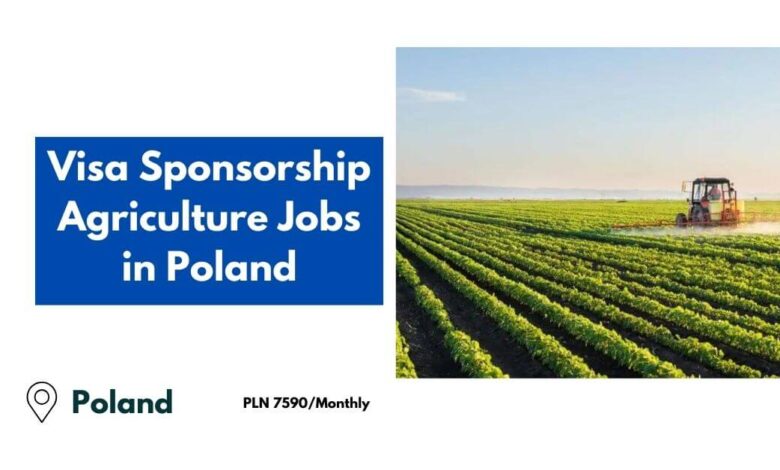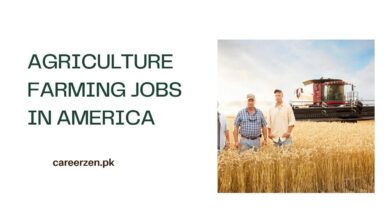Visa Sponsorship Agriculture Jobs in Poland 2024

The Rural Industry in Poland provides intriguing business opportunities that entice individuals to explore a variety of professional experiences. The development and collection of fungi is a frequent obligation of these positions, which are essential to the success of Poland’s rural sector.
The influx of outside laborers into Poland may be significantly influenced by visa sponsorship. This simultaneously alleviates the labor deficit and promotes cross-cultural trade and collaboration. Poland’s willingness to accept talented and productive individuals from all corners of the world is exemplified by the supported visas.
As a consequence of the expanding global and household markets for mushrooms, Poland has experienced a significant increase in labor requirements. Gifted faculty members are necessary to execute labor-intensive tasks, including sorting, pressing, and selecting. Individuals who have prior rural experiences and those who are interested in hands-on training in mushroom cultivation and management may both find employment in this sector. The mushroom development industry offers opportunities for both temporary and long-term business due to the consistent labor demands that peak during harvest seasons.
Check Also: Milk/ Dairy Factory Jobs in Poland Visa Sponsorship
Details of Visa Sponsorship Agriculture Jobs in Poland
| Country | Poland |
| Job | Agricultural Jobs |
| Education | High School Diploma |
| Experience | 2-3 Years |
| Visa Sponsorship | Yes |
Key areas in agriculture
The subsequent list comprises the most agricultural regions and their associated obligations:
Crop farming
The cultivation of various commodities may be considered a creation that encompasses their generation, development, and promotion. It necessitates specific agricultural sciences knowledge, apparatus capabilities, and equipment. Precipitation, rural item costs, cultivation apparatus, and labor are among the numerous variables that influence a farmer’s salary.
Fruit farming
Fruit cultivation encompasses the cultivation of vines, small trees, and natural products. A few natural product ranches have small plantations where the ranchers cultivate fresh produce that they harvest at various locations throughout the year. At farmers’ markets or neighborhood grocery stores, this product is available from numerous ranchers. The following are the most natural products for this type of cultivation:
- berries, such as strawberries, raspberries and blackberries
- melons, such as cantaloupes
- citrus natural products, such as oranges and lemons
- nuts, such as walnuts and pistachios
Horticulture
Horticulture is the cultivation of plants in gardens to provide sustenance or pharmaceuticals. It encompasses the management of plant materials to ensure their proper development, reproduction, and health through consideration, determination, and assistance. This is contingent upon the unique attributes of each type of tree, shrub, or bloom. You will be able to secure cultivation in both natural and conventional methods, contingent upon your preferences.
Livestock farming
Livestock cultivation encompasses the breeding and nurturing of animals to produce meat, milk, and eggs for commercial purposes. Animals provide a diverse array of material materials, including hide, fiber, and stowaways. It creates a pathway for the utilization of crop byproducts and other materials.
Poultry farming
The propagation of chickens and other poultry is a component of poultry cultivation. Ranchers have access to a diverse selection of poultry breeds that are available for commercial purposes. For instance, commercial egg-laying hens are frequently observed laying eggs within a poultry coop, where they necessitate conventional care, food, and water. On a daily basis, a rancher provides support to the chickens, treats them when they are weakened, and retrieves the eggs for sale.
Bee farming
Bee cultivation involves the maintenance of honey bees in bee sanctuaries to produce nectar, propolis, and other products. Beekeeping can be conducted on a variety of scales, ranging from a small domestic bee sanctuary on a terrace to a large commercial operation, depending on the beekeeper’s objectives. At the recreational level, you will engage in beekeeping to either support your connection to science or to generate income from honey or other products.
Aquaculture
The breeding and rearing of sea-going life forms in water, including angels, mollusks, shellfish, and oceanic vegetation, is referred to as aquaculture. A cultivator can collect mollusks and angles in the wild and house them in walled-in areas with the help of aquaculture. Aquaculture also encompasses coordinate culture or mariculture, which employs fish eggs, juvenile organisms, or vegetation of oceanic origin.
Agroforestry
Agroforestry is a management framework in which trees are grown on farmland in conjunction with produce and livestock. This approach integrates agricultural and ranger services to advance environmental sustainability and ensure food security. In order to prevent soil disintegration and provide shade for crops or livestock, farmers can plant trees as windbreaks or walls in agroforestry. Additionally, these trees can enhance soil quality by avoiding soil compaction, increasing organic matter, and adding supplements.
Aquaponics
Aquaponics may be a framework that combines the cultivation of aquatic organisms and vegetation in a harmonious environment. It integrates aquaculture, which is the cultivation of oceanic life forms such as angle, mollusks, and shellfish, with hydroponics, which is a potential approach to the cultivation of plants in water or sediment. In this framework, the water is directed from angle containers and subsequently pumped into the hydroponic system.
Energy farming
Energy cultivation involves the utilization of renewable energy sources, including biofuel, solar, wind, and geothermal regulation. This type of farming is characterized by the utilization of renewable energy sources and the reduction of waste emissions. It provides a means to generate energy and support agriculture in numerous regions where conventional farming is not feasible due to hilly terrain, the necessity for soil supplements, or inclement weather.
Agriculture Laborer Requirements
- Assisting with routine cultivation tasks
- Utilizing agricultural equipment
- Upkeep and repair of agricultural apparatus and structures
- Keeping track of agricultural records
- Executing obligations related to creature cultivation
Duties of Agriculture Jobs in Poland
- Planting and harvesting produce
- Maintaining livestock
- Maintaining and operating agricultural apparatus
- Upkeep and repair of agricultural structures and fences
- The application of pesticides and manures
- Editing the welfare of creatures and monitoring their activity
Benefits of Visa Sponsorship Agriculture Jobs in Poland
- Legal Work Authorization: Visa sponsorship grants the requisite legal authorization to engage in employment in Poland, thereby minimizing legal risks and guaranteeing adherence to immigration regulations.
- High Demand for Labor: Poland’s agricultural sector is robust, resulting in a consistent demand for labor, particularly during prime seasons, which can contribute to job stability.
- Competitive Salaries: Numerous agricultural positions offer competitive salaries, and certain employers may also offer supplementary benefits, including overtime pay and incentives.
- Skill Development: The agricultural industry provides individuals with the opportunity to develop practical skills in the operation of machinery, vegetation management, and various farming techniques, thereby increasing their employability in the industry.
- Permanent Residency Pathway: Certain visa sponsorship programs may result in permanent residency options, which offer long-term security to laborers and their families.
- Cultural Exposure: The opportunity to engage with local communities, learn about traditional agricultural practices, and experience a distinct culture is provided by working in Poland.
- Supportive Work Environment: Numerous agricultural employers prioritize a positive work culture by offering employees training, safety measures, and assistance.
- Opportunities for Seasonal Employment: Agriculture positions frequently include seasonal employment opportunities, which enable employees to generate income during specific periods while maintaining the freedom to pursue other interests.
- Benefits Accessibility: Certain employers may provide supplementary benefits, including transportation allowances, health insurance, and accommodation assistance.
- Networking Opportunities: Employment in agriculture can facilitate the development of connections within the industry, which may result in future partnerships or employment opportunities.
Application Strategy for Agrarian Jobs
Use the connection provided below to apply for this position.
Frequently Asked Questions:
-
What is the salary in agriculture in Poland?
The salary range for people working in Poland in the agriculture and food industry is typically from 4,378 PLN (minimum salary) to 9,256 PLN (highest average; actual maximum salary is higher).
-
Is Poland good for agriculture?
Poland’s agriculture saw a sharp increase in production value and agrifood product exports.
-
What is the scope of agriculture in Poland?
Poland’s agricultural sector is vital for the European and global markets because it produces a variety of agricultural, horticultural, and animal-origin products. The surface area of agricultural land in Poland is 15.4 million ha, which constitutes nearly 50% of the total area of the country.



